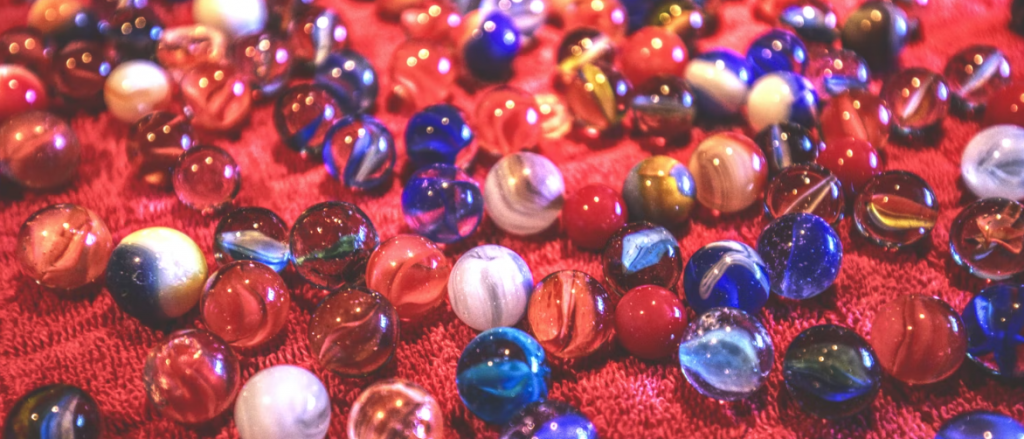A couple weeks ago, I saw a TikTok video that blew my mind, leading me down multiple rabbit holes, starting with the epiphany that marbles are made on a marble run?! What an exciting way to be born.
The Soundtrack
The first thing I wondered about was the background music of the video, which came from a channel of Chinese industrial videos and seemed like a strange match even for TikTok.
Some digging led me to 77-year-old German musician Achim Reichel’s “Aloha Heja He,” a pop-rock sea shanty that was a hit for him in the early 1990s, one of several albums of sea shanties he’d recorded since the 1970s.
As explained in this Der Spiegel article from December, the song found a new life because of a middle-aged bachelor known as “Student Zhang” (or “Classmate Zhang”) who shares his life in rural northeastern China with over 19M followers on Douyin, TikTok’s Chinese counterpart.
Nearly every one of Zhang’s videos using the song as its soundtrack, though I couldn’t figure out why.
Where Marbles Are Made
The original TikTok video was from a factory in China, which naturally led me to search for videos of other marble factories to see how they produced their own marbles. Here’s a 2011 tour of a marble factory in Ningbo, a major city on the east coast of China.
Unfortunately, there’s only one surviving marble factory in the United States, Marble King in Paden City, West Virginia.
In November 1983, Mister Rogers’ Neighborhood showed how marbles were made at the Marble King factory. It’s an incredibly soothing behind-the-scenes tour, accompanied by Johnny Costa’s iconic piano jazz. You can watch the clip below, or the show in its entirety on the Internet Archive starting at the 8 minute mark.
In 2010, Jabo Inc. of Reno, Ohio closed its doors, leaving Marble King the last factory standing. Before it did, owner/glass artist Dave McCullough fired up the furnace one last time for a group of collectors who raised $50,000 for a 120,000 marble run. The story is worth reading:
Jabo master craftsman David McCullough came out of retirement to make one more run of the large marbles using the old kiln he declared ready for the scrap heap a year ago.
After years of begging by Steve Sturtz, a marble collector who splits his time between Alexandria Bay, N.Y., and Kingston, Ont., McCullough agreed to fire up the old furnace again, but with no guarantees how long it would hold up.
Here’s a tour of the Jabo Inc factory in 2004, which mentions that the molten blobs of glass are called “gobs.” (These really are Forbidden Gobstoppers.)
Losing Your Marbles
Seeing thousands of marbles churning through elaborate marble runs raised a frequent question: who are all these marbles for? Is there really this much demand in the world for marbles?
These days, the interest in marbles as toys for children is pretty low. There are a small but dedicated group of adult marble collectors out there, but most glass marbles these days are produced for industrial use: for air and water filtration systems, as agitators in aerosol spray cans, and for decorative planters.
But there are YouTube creators who have found big audiences with entertaining marble content. With 1.3M subscribers, Jelle’s Marble Runs is best known for their incredible marble rallies with full color commentary.
Marble Station makes ASMR videos for over 1.7M subscribers, with eight current livestreams of non-stop marble content and over 385M views.
And no mention of marble content would be complete without Wintergatan, the Swedish band responsible for the Marble Machine, a hand-cranked musical marble run, and its successor, the Marble Machine X.
The creation of the Marble Machine X was painstakingly documented in over 170 videos over 4.5 years, funded by fans through Kickstarter and Patreon, but abandoned late last year by its creator Martin Molin, with a disappointing and confusing video and accompanying announcement, citing inspiration from Elon Musk, management theory books, and “blockchain experts” who encouraged him to start from scratch with a new design as a DAO.
Molin cited multiple design flaws in the decision to restart, with several places where marbles could get lost. Let’s hope he finds them again someday.


Maybe it’s not exactly a “marble factory” by some definition, but we’ve had this Kansas City marble business on our list to visit the next time we head that way:
https://www.moonmarble.com
They used to have regular demonstrations and visiting hours, and my hope is that some day they’ll be able to offer that again.
Yes! I found Moon Marble in my searching too, one of several U.S. manufacturers that still make glass marbles by hand, instead of in bulk with machines. They did a demo for a local news show in 2017.
I can’t figure out how they get their colors, especially the marbles that have more than one color, or the clear ones with a colors bit on the inside. Is it all from the original raw glass and the combinations that go into the furnace?
Good question! The color in marbles is made from swirls of molten colored glass injected into the transparent molten glass. The shape and final design are determined by the speed and force of the injection, and grooved spinning cups could create spiral corkscrew designs.
Wow, that was rather relaxing! I have a box full of marbles but never stopped to consider how they were made. Thanks for the article.